|
|
|
Sort Order |
|
|
|
Items / Page
|
|
|
|
|
|
|
| Srl | Item |
| 1 |
ID:
118602
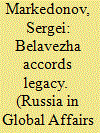

|
|
|
|
|
| Publication |
2012.
|
| Summary/Abstract |
The USSR ceased to exist in December 1991, but the dramatic events of the two subsequent decades have shown that it is premature to view its collapse as a closed chapter of history. The termination of the Soviet Union's existence as a legal fact and the historical process of its disintegration are different things. The country that accounted for one-sixth of the planet's land is gone from the world map, but the disintegration of Soviet statehood persists. Like the breakup of the Western Roman Empire does not boil down to the abdication of Romulus Augustus, or the French Revolution to the storming of the Bastille, or Russia's 1917 October Revolution to the October 25 (in the Julian calendar) coup, the breakup of the USSR is not confined to the December 1991 Belovezha declaration by heads of states of Russia, Ukraine and Belarus on its dissolution. That the process still continues is evidenced by eight armed conflicts, the de-facto emergence of new states (two of which have won international, albeit limited, recognition), unending border disputes, ethnic and religious clashes, and regional conflicts. In 2008 a precedent was created when the borders of former Soviet republics were redrawn. Given unsettled ethno-political conflicts, it is hard to predict when and how these borders will be recognized, and where the self-determination process, launched by Mikhail Gorbachev's perestroika policy, will stop.
|
|
|
|
|
|
|
|
|
|
|
|
|
|
|
|
| 2 |
ID:
004179
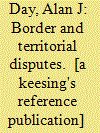

|
|
|
|
|
| Edition |
2nd ed
|
| Publication |
Essex, Longman, 1987.
|
| Description |
x, 462p.; maps
|
| Standard Number |
0582009871
|
|
|
|
|
|
|
|
|
|
|
|
Copies: C:1/I:0,R:0,Q:0
Circulation
| Accession# | Call# | Current Location | Status | Policy | Location |
| 031035 | R 341.42/DAY 031035 | Main | On Shelf | General | |
|
|
|
|
| 3 |
ID:
015825


|
|
|
|
|
| Publication |
Feb 1993.
|
| Description |
67-76
|
|
|
|
|
|
|
|
|
|
|
|
|
|
|
|
| 4 |
ID:
072976
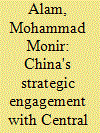

|
|
|
| 5 |
ID:
090400
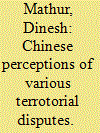

|
|
|
|
|
| Publication |
2008.
|
| Summary/Abstract |
China has common land frontiers with North Korea, Russia, Kazakhistan, Khirgizistan, Tadzikistan, Mongolia, afghanistan, Pakistan, India, Nepal, Bhutan, Myanmar, Vietnam and Laos. Small wonder that the communists, on coming to power in 1949, recorded 119 border problems with the neighbours. Against India, what was essentially a semi-ratified Indo-Tibetan border problem, became a full-fledged Sino-Indian border dispute.
|
|
|
|
|
|
|
|
|
|
|
|
|
|
|
|
| 6 |
ID:
192954
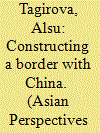

|
|
|
|
|
| Summary/Abstract |
The Russian and Soviet governments believed the border to be a social and political construct. They often described and considered it as a foreign policy issue and a point of military vulnerability. In the course of 70 years of Sino-Russian relations since 1949, the border turned from a porous imperial fringe to a line of defense, a zone of economic growth, and a zone of economic anxiety. Throughout this evolution process, the Russian central government failed to grant agency to the local authorities and indigenous communities. The article argues that the current Russian federal government entrusts the local government with two conflicting goals in the borderlands: building strong cross-border ties and maintaining a "strong vertical of power" with top-down management and absolute supremacy of national security matters.
|
|
|
|
|
|
|
|
|
|
|
|
|
|
|
|
| 7 |
ID:
079903


|
|
|
|
|
| Publication |
2007.
|
| Summary/Abstract |
Irredentism developed into an anomaly in post-World War II Europe and - contradicting the dire predictions of the 1990s - has remained an anomaly even since the end of the Cold War. Focusing on the renunciation of the FRG's and the Republic of Ireland's irredentist claims, I propose a novel route to analyse dispute settlement. I contend that nations justify their stance in a conflict. In the case of irredentism, they do not merely assert that a disputed territory is their land but justify to themselves and others why the disputed territory is rightfully theirs and why pursuing the irredentist stance is worthwhile. The disruption of this justification - what I call dejustification - constitutes a pathway to dispute settlement. Dejustification occurs through a change of the ideational environment that serves as the resource for justifying the claim and an advocacy that constructs a mismatch between environment and claim
|
|
|
|
|
|
|
|
|
|
|
|
|
|
|
|
| 8 |
ID:
184875
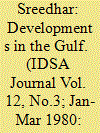

|
|
|
| 9 |
ID:
171228
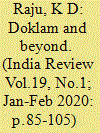

|
|
|
|
|
| Summary/Abstract |
Sovereignty over territory is the founding principle of international legal order and essential for the implementation of the sovereign rights of a State. Territorial disputes become commonplace among countries, mainly when bilateral agreements do not explicitly demarcate them. India and China are two Asian giants when it comes to population and economy. The recent cross-border tension between India and China has at its vortex the issue of the Doklam plateau region which shares borders with three countries namely India, Bhutan, and China and is popularly known as the “Tri-Junction.”
The present article re-visits the history of the Indo-China border dispute and tries to explain the legal aspects of border disputes under international law. It closely analyzes the principles applicable to these disputes and the decisions of various international institutions that are relevant. Furthermore, the article examines bilateral agreements to understand the possible violations and consequences under international law. It is argued that the peaceful co-existence between India and China must be of paramount importance to ensure Asian security and well-being. Keywords: India, China, Bhutan, Doklam, Territorial Disputes.
|
|
|
|
|
|
|
|
|
|
|
|
|
|
|
|
| 10 |
ID:
157557
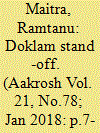

|
|
|
| 11 |
ID:
073976


|
|
|
|
|
| Publication |
2006.
|
| Summary/Abstract |
Our article analyzes the impact of the European Union (EU) on border conflicts, in particular how integration and association are related to conflict transformation. We approach this issue from a theoretically as well as empirically grounded constructivist perspective. On this basis we propose a stage model of conflict development, based on the degree of securitization and societal reach of conflict communication. We argue that the EU can transform border conflicts and propose a four pathway-model of EU impact. This model comprises forms of EU impact that are, on the one hand, either actor-driven or indirectly caused by the integration process and have, on the other hand, as their main target either particular policies or the wider society in border conflict areas. We then apply this model to a comparative study of border conflicts, thereby analyzing the conflicts in Northern Ireland, Greece-Turkey, Cyprus, Europe's North (EU-Russia) and Israel-Palestine. We finish with a specification of the conditions of positive and negative EU impact.
|
|
|
|
|
|
|
|
|
|
|
|
|
|
|
|
| 12 |
ID:
125450
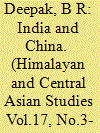

|
|
|
|
|
| Publication |
2013.
|
| Summary/Abstract |
Ever since the formulation of common borders between India and China during the 19th and 20th Centuries, these sailing for Sino-Indian relations has not been smooth. The course of Sino-Indian relationship was filled with the ramps of mistrust, jealousy, hearted and arms conflicts. The territorial aggrandizement of the British and Manchu imperialism turned the peaceful Himalayan region into an area of protracted contest between India and China
|
|
|
|
|
|
|
|
|
|
|
|
|
|
|
|
| 13 |
ID:
135468
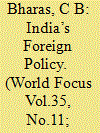

|
|
|
|
|
| Summary/Abstract |
Thus, it is clear that “With the gradual accretion of power by states such as China and India, the world may now be witnessing a major shift in power dynamics.” The Sino-Indian security relations shall have a tremendous impact on future and over all stability of Asia. When the security system of a state shall be at stake, when internal disturbance shall be cause of concern and in an environment of international terrorism, a security-centric national policy will of course, be given priority.
|
|
|
|
|
|
|
|
|
|
|
|
|
|
|
|
| 14 |
ID:
109728
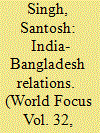

|
|
|
| 15 |
ID:
031674
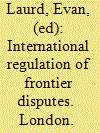

|
|
|
|
|
| Publication |
London, Thames and Hudson, 1970.
|
| Description |
247p.
|
| Series |
Studies in International order
|
| Standard Number |
0500250251
|
|
|
|
|
|
|
|
|
|
|
|
Copies: C:1/I:0,R:0,Q:0
Circulation
| Accession# | Call# | Current Location | Status | Policy | Location |
| 004459 | 327/LUA 004459 | Main | On Shelf | General | |
|
|
|
|
| 16 |
ID:
154701
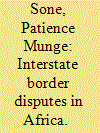

|
|
|
|
|
| Summary/Abstract |
Many researchers have focused on the role colonialism has played in causing interstate border disputes in Africa. Besides the colonial issue, this paper seeks to investigate what other factors fuel interstate border disputes in Africa and determine how effectively the disputes can be resolved. In recent decades, Africa has been tormented by and is still experiencing numerous interstate border disputes which have serious implications for the disputing states. Some of the disputes are resolved, but violations of human rights and instability still occur in these regions. By analysing the content of some relevant documents and with the use of interviews, this paper reveals that most disputing African states rely heavily on foreign intervention (especially by their erstwhile colonial masters) in the resolution of their disputes. It is argued that African leaders need to be more committed and exhibit better leadership in resolving their border disputes, and that they should always seek the expertise of African forums such as the African Union (AU) before calling for foreign intervention. It is suggested that African leaders and the AU understand the problems of Africans better than anyone else, and they are also the ones mostly greatly affected by these disputes. Thus, there needs to be more of a focus on addressing the root causes of disputes in order to avoid them resurfacing, rather than seeking to merely halt them.
|
|
|
|
|
|
|
|
|
|
|
|
|
|
|
|
| 17 |
ID:
128129
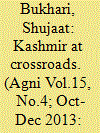

|
|
|
|
|
| Publication |
2013.
|
| Summary/Abstract |
For a long time now Kashmir has been in a status quo in all respects. With a stalemate in peace process between India and Pakistan, Kashmir has been off the agenda, thus giving rise to moments of despair and disillusionment. The result of this discontentment is very much visible on the ground and even a musical concert; otherwise see, as a soothing intervention in a conflict state is shadowed under a barrage of criticism, Zubin Mehta did play with his musical magic in Shalimar garden but the massage that went out was the Kashmir and Kashmiris were not happy with a gesture, which they see strongly believe is to present Kashmir as "normal and peaceful".
|
|
|
|
|
|
|
|
|
|
|
|
|
|
|
|
| 18 |
ID:
125592
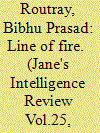

|
|
|
|
|
| Publication |
2013.
|
| Summary/Abstract |
Tension between India and Pakistan are rising again following the killing of five Indian soldiers. Dr. Bibhu Prasad Routray investigates the states of relations between the two countries, and analyses the political risks of escalation.
|
|
|
|
|
|
|
|
|
|
|
|
|
|
|
|
| 19 |
ID:
125382
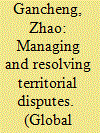

|
|
|
|
|
| Publication |
2013.
|
| Summary/Abstract |
Territorial disputes between China and some of its neighbors are of the most spectacular issues in the region. there are deep concerns about what is going on between China, the rising power of the world arena, and the Asia-Pacific neighbors over territorial disputes and differences in maritime rights. From these ongoing disputes, these are also speculations on the real motives of relevant parties, and naturally, lot of suspicions have come up constantly, destructing the regional environment for common development.
|
|
|
|
|
|
|
|
|
|
|
|
|
|
|
|
| 20 |
ID:
124699
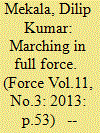

|
|
|
|
|
| Publication |
2013.
|
| Summary/Abstract |
On October 24, Indo-Tibetan Border Police (ITBP) celebrated its 52nd anniversary with a ceremonial parade at the Tigri campus, New Delhi. Looking back at the past year, ITBP can't seem to deny that this has been the most challenging year for their personnel. Starting with the incursions of the Chinese Army at the Line of Actual Control (LAC) in April, which led to the face-off between the Chinese and the Indian forces at the border, to the Uttarakhand flood rescue efforts, considered the biggest ever operation till date, the ITBP faced tough challenges this year. This was again followed by more incursions from the Chinese Army in the subsequent months.
But the good news is that the ITBP is getting a major push from the government to develop its infrastrusture both at the border and its various headquarters in the mainland. Speaking at the Raising Day parade, chief guest R.P.N. Singh, minister of state (Home) said that the government has sanctioned Rs 1,260 crore for construction on the ITBP locations. It includes accommodation for jawans, construction of forward locations and other operational and administrative buildings and structures. He also said that measuring eco-friendly stride towards energy requirement, a total of 69 forward ITBP posts would soon have three to 10 KVA solar power plants which will facilitate uninterrupted power supply for various needs.
|
|
|
|
|
|
|
|
|
|
|
|
|
|
|
|
|
|
|
|
|